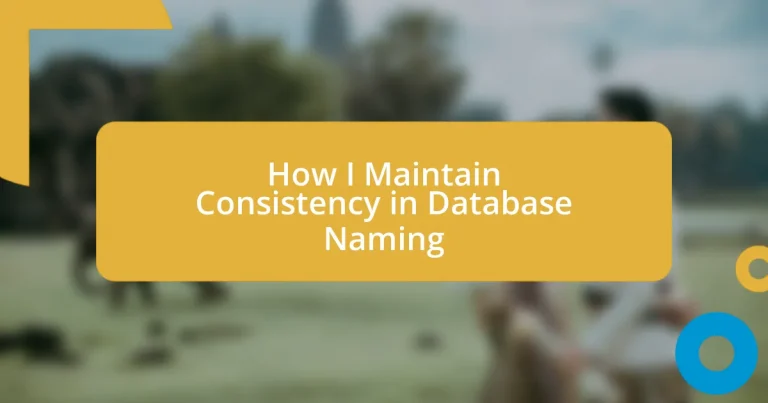Key takeaways:
- Consistent database naming conventions improve clarity, enhance collaboration, and streamline maintenance, ultimately driving productivity.
- Avoid common mistakes such as using non-descriptive names, inconsistent formats, and excessive abbreviations to prevent confusion and improve understanding.
- Utilize tools like SQL Server Management Studio and documentation platforms to enforce naming standards and maintain consistency over time.
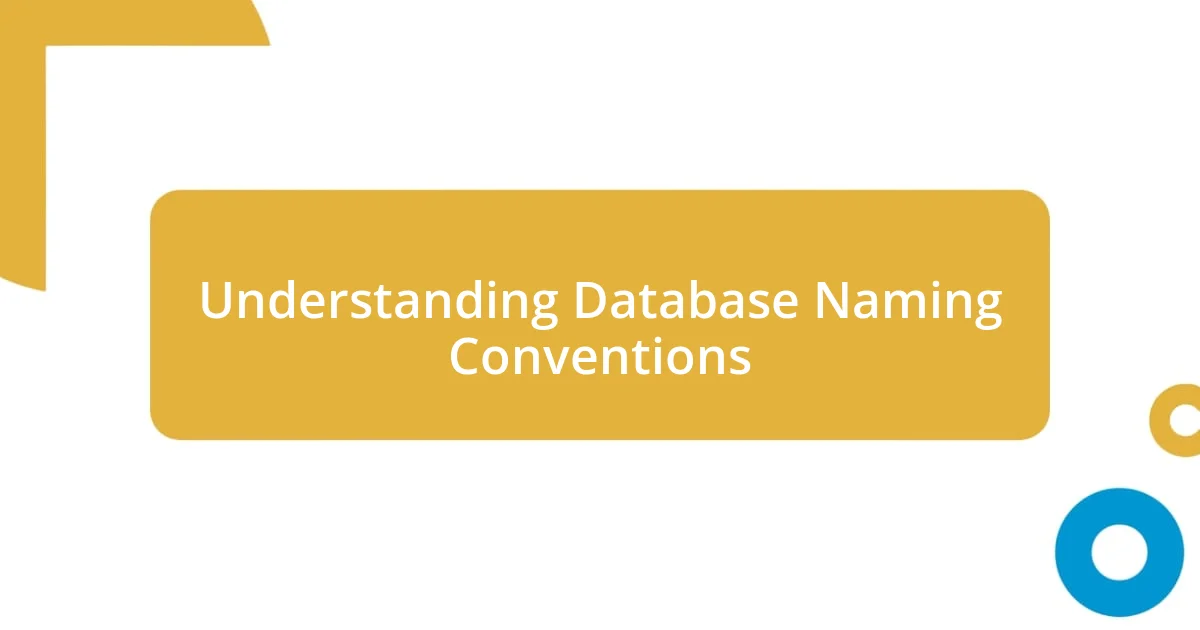
Understanding Database Naming Conventions
Understanding database naming conventions is crucial for ensuring clarity and coherence in your projects. I remember early in my career getting lost in a sea of poorly named tables and columns. Have you ever felt that frustration? A well-structured naming convention not only eliminates confusion but also enhances collaboration among team members.
When I first adopted a systematic approach to naming, I noticed a significant difference in my productivity. For instance, using prefixes to indicate the type of data—like ‘tbl‘ for tables or ‘vw‘ for views—allowed me to quickly identify the purpose of each entity. It’s like having a personal organizational system that translates into efficient coding practices.
Consistency is the heart of effective naming conventions. I once worked on a team where we had differing styles for naming similar entities, leading to endless miscommunication. That experience taught me that adopting a shared set of rules isn’t just beneficial – it’s essential for project success. How do you keep your naming conventions aligned?
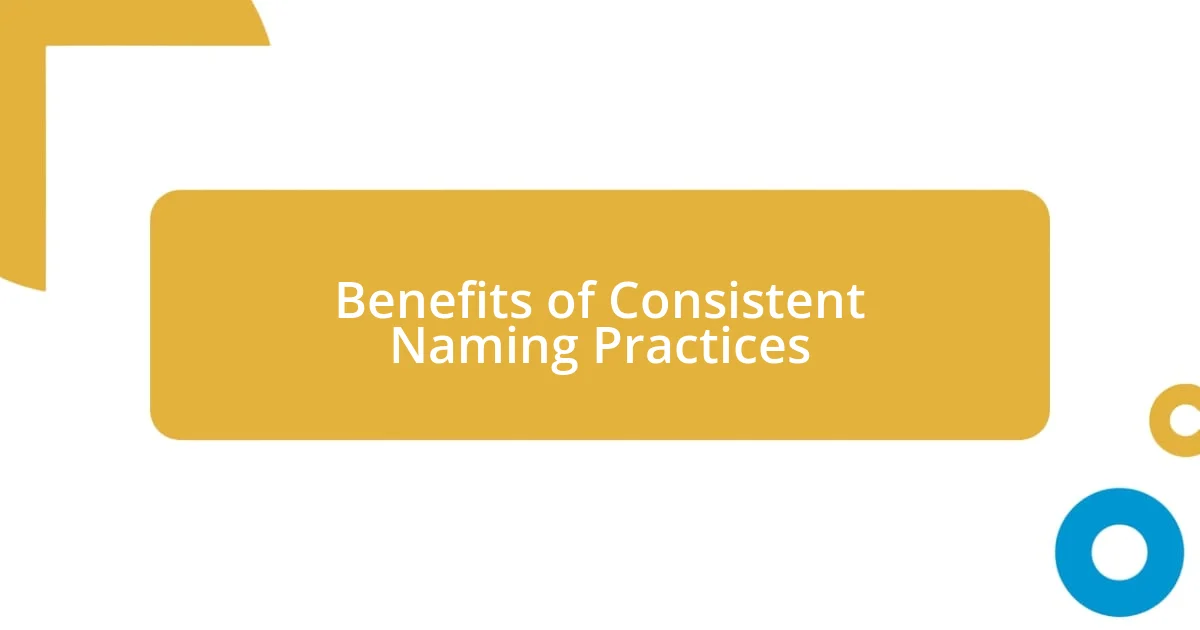
Benefits of Consistent Naming Practices
Maintaining consistent naming practices offers several profound benefits that can transform your database management experience. I distinctly remember the relief I felt when I implemented a uniform naming system. It was as if the chaotic jumble of tables and columns melted away, allowing me to focus more on building features rather than deciphering names.
Here are some key advantages of consistent naming practices:
- Improved Clarity: Clear names reduce ambiguity, making it easier for anyone interacting with the database to understand its structure and purpose.
- Enhanced Collaboration: When everyone uses the same naming conventions, it fosters teamwork and reduces errors that stem from miscommunication.
- Streamlined Maintenance: With a consistent system, updates and modifications become significantly easier, as the predictable naming makes locating entities straightforward.
- Reduced Learning Curve: New team members can get up to speed faster without having to unravel naming conventions that are inconsistent or convoluted.
- Greater Scalability: A well-organized naming system lays a solid foundation for future expansion, ensuring that as the database grows, it remains manageable.
I can’t emphasize enough how these benefits ease the overall workflow. When I see well-named variables, it feels like a breath of fresh air, inviting productivity to flow naturally. Such a simple change can yield profound results!
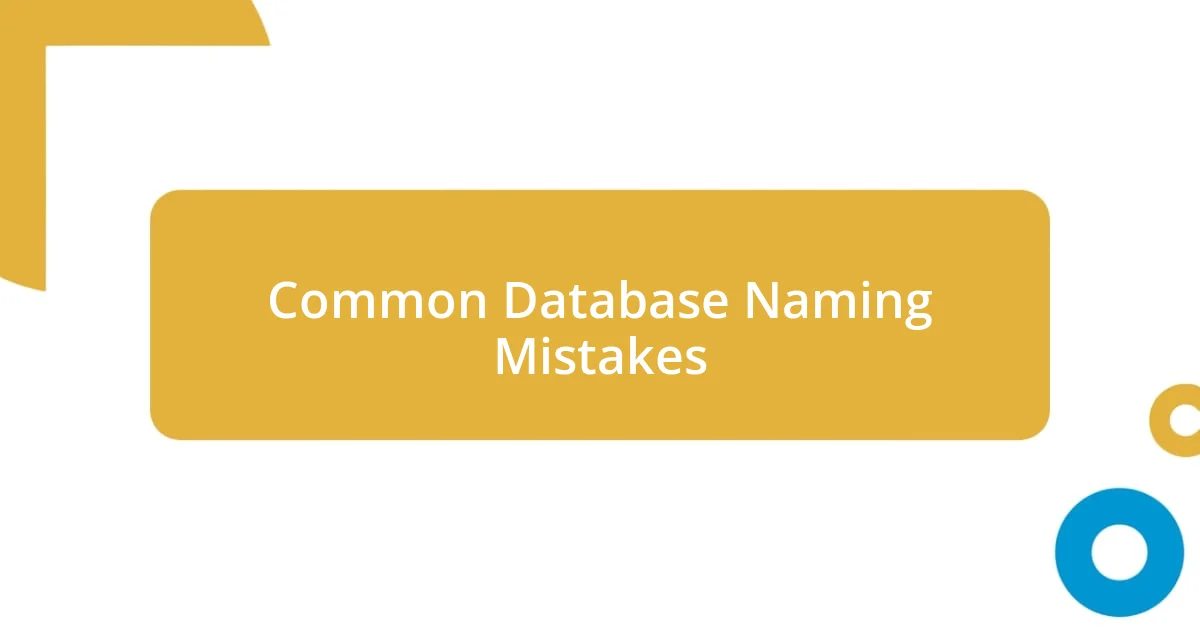
Common Database Naming Mistakes
Understanding the common mistakes in database naming can save a lot of heartache down the line. One of the biggest blunders I’ve witnessed is using non-descriptive names. I remember a project where tables were named ‘Data1’, ‘Data2’, and so on. It created confusion–not only for me but for the entire team. Being unclear can lead to a frustrating guessing game, forcing you to figure out what each table actually contains.
Another pitfall is inconsistently mixing naming conventions. I once joined a project where some variables were named in camelCase while others were in snake_case. This inconsistency felt chaotic and made navigating the database like trying to read a foreign language. It’s essential to settle on a convention and stick to it; otherwise, you risk opening a can of worms when it comes to understanding your structures down the line.
Lastly, abbreviations can be a double-edged sword. While they might save a few keystrokes, excessive shortening can obscure meaning. I learned this when I encountered a column named ‘actvtyCd’. Initially, I thought it was a code for activities, but it turned out to mean ‘Activity Code.’ A moment of clarity turned into a whole day of confusion. Always aim for names that convey meaning rather than relying on cryptic abbreviations.
| Mistake | Explanation |
|---|---|
| Non-descriptive names | Fails to convey meaning, leading to confusion. |
| Inconsistent naming conventions | Makes navigation difficult and creates a chaotic environment. |
| Excessive abbreviations | Can obscure meaning and complicate understanding. |
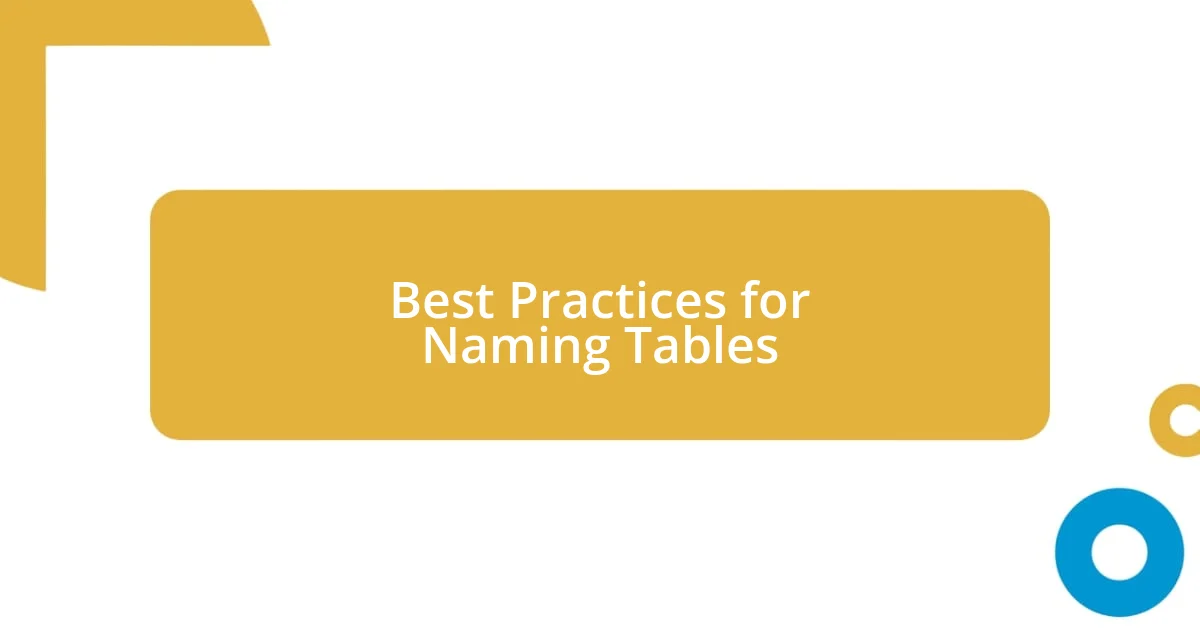
Best Practices for Naming Tables
When it comes to naming tables, I’ve learned that clarity is essential. I remember a project where we had a table labeled simply as “Users.” It wasn’t until later that I realized we had multiple user types: admins, clients, and guests. Imagine the confusion when trying to query specific information! Naming tables like “AdminUsers,” “ClientUsers,” and “GuestUsers” would have eliminated this issue, highlighting the importance of clarity from the get-go.
Another aspect I find crucial is consistency in naming conventions. In a recent team project, we adopted a specific format for table names, using singular nouns and PascalCase. I felt a sense of relief when I saw everyone sticking to this convention. It created a sense of belonging, as if we were all in sync. Why complicate things with varying styles? Pick a convention that suits your project and remain steadfast. It not only eases communication but establishes a professional standard that everyone can appreciate.
Lastly, I’ve found it helpful to include a prefix that reflects the context of the table. For example, if I had a table that stored customer orders, naming it “Orders_Customer” rather than just “Orders” made its purpose crystal clear. Drawing from my experience, I sometimes articulate to my team: “Think of your table names as the foundation of your database—it sets the stage for everything that comes after. So, let’s make sure that foundation is rock solid!” Engaging in this dialogue ensures we create a system that everyone understands and values.
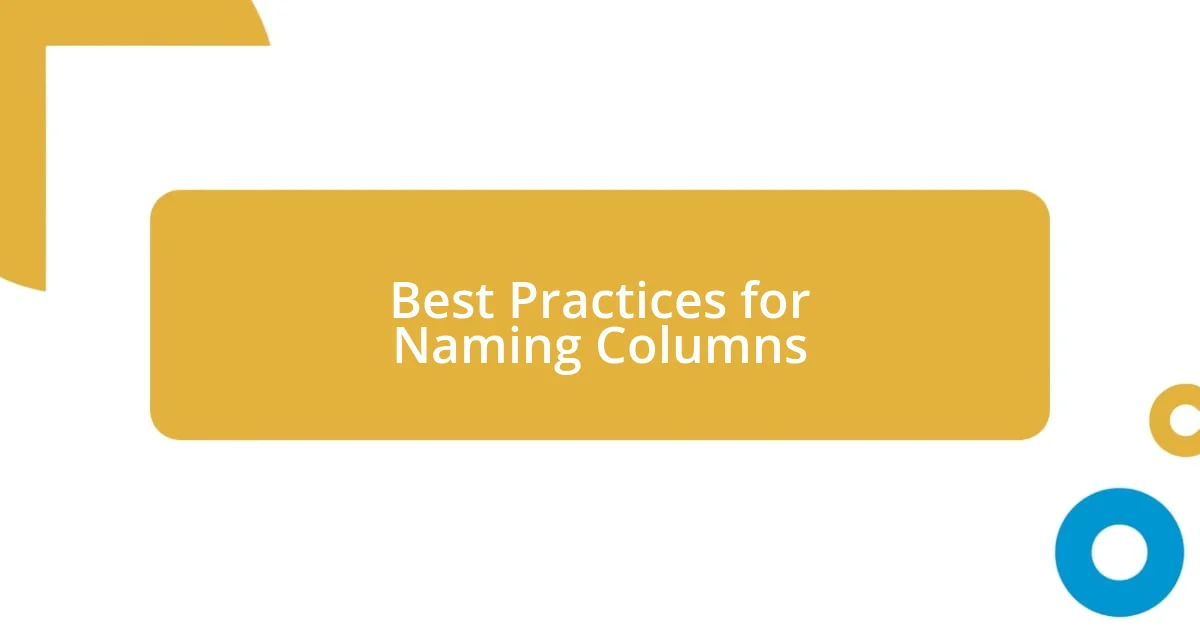
Best Practices for Naming Columns
When it comes to naming columns, being descriptive is paramount. I recall working on a project where a column was labeled simply “Value.” At first, it felt like a generic placeholder, making it impossible to decipher its true purpose without digging deeper into the data. Reflecting on that experience, I realized that a more specific name, like “SalesAmount” or “OrderTotal,” could have saved us all a headache and made our queries more intuitive.
I’ve also found that maintaining a consistent naming convention across all your columns fosters clarity. In my experience, I once dealt with a database that included a mix of singular and plural forms, which often left me second-guessing whether I was pulling the right data. It’s amazing how something as seemingly trivial as consistency can enhance both readability and accessibility. So, I always encourage my teammates to select a single convention—be it snake_case or camelCase—and stick with it throughout the entire database.
Last but not least, I’ve come to appreciate the power of proper suffixes in column names. For example, using “DateCreated” instead of just “Date” can instantly clarify what the date represents. I often ask myself and my team, “What happens if someone new joins us tomorrow? Will they understand what we’re working with?” By including meaningful descriptors, we not only ease the onboarding process but also make our database a lot more user-friendly. After all, we want our data to speak for itself, right?
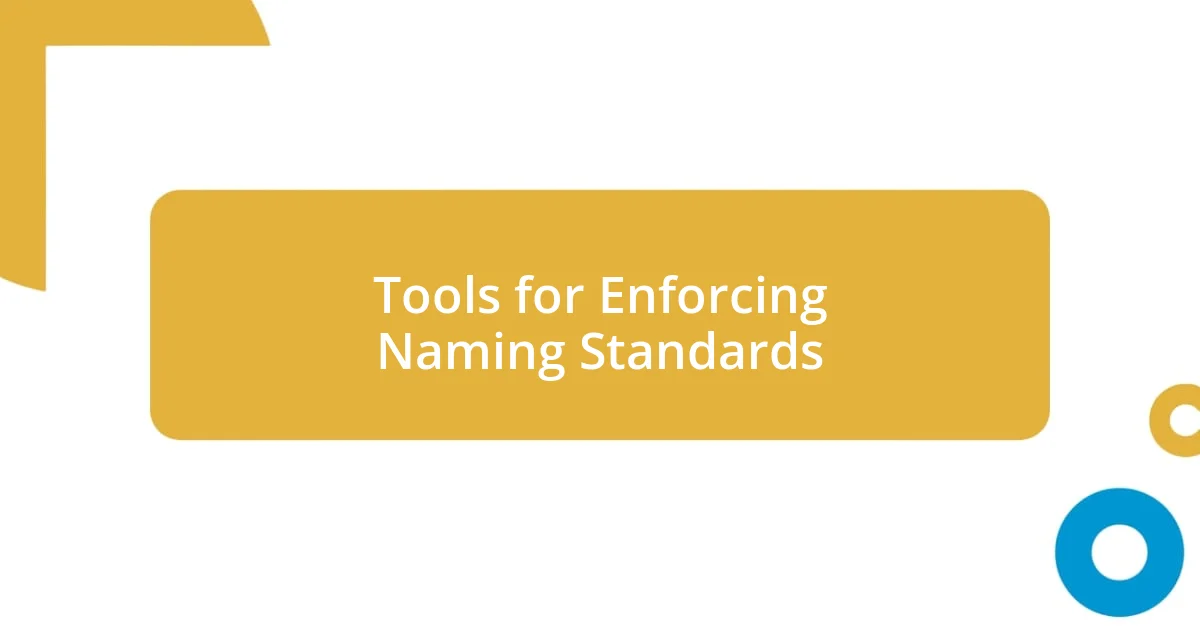
Tools for Enforcing Naming Standards
When it comes to enforcing naming standards, I’ve found that using database management tools like SQL Server Management Studio (SSMS) can really simplify the process. I remember spending countless hours reviewing our schema manually, only to realize the inconsistencies we overlooked. With SSMS, you can create and implement naming conventions through scripts, which not only saves time but also reduces human error.
In addition to traditional database tools, I’ve also started utilizing automated code review tools, such as SonarQube. These platforms provide insights on naming discrepancies that often go unnoticed. It’s fascinating to see how they flag issues in real-time; this allows me to address problems as they arise rather than stumbling upon them during a later phase. I often think, “What if we could catch these errors before they become significant?” Being proactive has truly transformed how I view database maintenance.
Finally, I’ve come to appreciate the value of documentation tools like Confluence or Notion. They act as a living record of our naming conventions and standards, allowing for easy access by all team members. I can’t tell you how many times newcomers have expressed gratitude for having clear guidelines at their fingertips. It’s a small effort that fosters a sense of teamwork, ensuring everyone feels empowered to follow the same path. Wouldn’t you agree that having a shared resource minimizes confusion immensely?
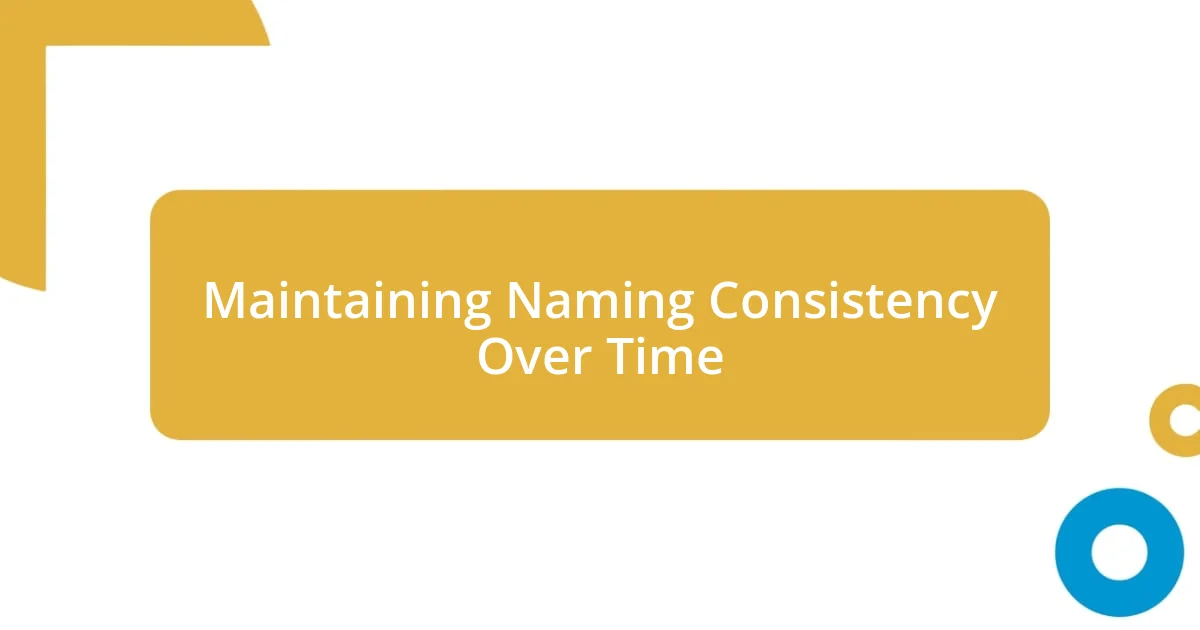
Maintaining Naming Consistency Over Time
Maintaining naming consistency over time often feels like an uphill battle. I remember when I first joined a team that had adopted an ad-hoc approach to naming conventions. It left me rattled, having to memorize random prefixes and suffixes for different tables. Over time, I learned that establishing a clear set of naming standards from the beginning and encouraging my peers to adhere to them makes it easier to onboard new members. So, I often ask myself, “How can we make this intuitive for everyone?” The answer always points back to consistency.
One practical step I’ve taken is scheduling periodic review sessions to revisit our naming conventions. This prevents them from falling by the wayside as projects evolve. During one such meeting, we realized that an old convention still in use didn’t align with newer projects, creating confusion. The “aha” moment there reminded me that naming standards aren’t static—they need to evolve. I find that these discussions not only help to refresh our memory but also foster a sense of team collaboration that’s invaluable.
I also encourage documenting any changes we decide upon. Reflecting on a challenging project, I kept a log of our discussions and decisions on naming conventions. This practice paid off when someone new joined the team; they were able to reference our thought process rather than guess the reasoning behind certain names. After all, who wouldn’t prefer having a well-organized guide over relying on a haphazard list? For me, clarity in filenames enriches our collaborative spirit and keeps the confusion at bay.












